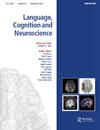Processing of acoustic and phonological information of lexical tones at pre-attentive and attentive stages
IF 1.8
3区 医学
Q2 AUDIOLOGY & SPEECH-LANGUAGE PATHOLOGY
引用次数: 0
Abstract
ABSTRACTWhile Mismatch Negativity (MMN) and P300 have been found to correlate with the processing of acoustic and phonological information involved in speech perception, there is controversy surrounding how these two components index acoustic and/or phonological processing at pre-attentive and attentive stages. The current study employed both passive and active oddball paradigms to examine neural responses to lexical tones at the two stages in Cantonese speakers, using the paradigm of categorical perception (CP) where the between- and within-category deviants share the same acoustic distance from the standard but differ in the involvement of phonological information. We failed to observe a CP effect in P300, which might indicate that this component doesn’t necessarily index phonological processing, while MMN does, as reflected by the finding of a greater MMN amplitude elicited from the between-category than within-category deviant. Nevertheless, phonological processing might be overridden by acoustic processing among participants who were sensitive to pitch.KEYWORDS: Acoustic informationphonological informationmismatch negativityP300categorical tone perception Disclosure statementNo potential conflict of interest was reported by the author(s).Additional informationFundingThis study was supported by a grant from the Research Grants Council of Hong Kong (GRF: 15610321).注意前和注意阶段词汇声调的声学和语音信息加工
摘要失配负性(MMN)和P300被发现与语音感知中涉及的声学和语音信息加工相关,但关于这两个成分如何在注意前和注意阶段指示声学和/或语音加工存在争议。本研究采用主动和被动两种模式,采用范畴感知范式,研究了粤语使用者在两个阶段对词汇语调的神经反应。范畴感知范式中,范畴内和范畴间偏差与标准语音距离相同,但涉及的语音信息不同。我们未能在P300中观察到CP效应,这可能表明该成分不一定指示语音加工,而MMN则可以,这反映在发现类别间偏差比类别内偏差引起的MMN振幅更大。然而,在对音高敏感的参与者中,语音加工可能被声学加工所覆盖。关键词:声学信息语音信息错配否定性300分类语气感知披露声明作者未报告潜在的利益冲突。本研究由香港研究资助局拨款(GRF: 15610321)资助。
本文章由计算机程序翻译,如有差异,请以英文原文为准。
求助全文
约1分钟内获得全文
求助全文
来源期刊

Language Cognition and Neuroscience
AUDIOLOGY & SPEECH-LANGUAGE PATHOLOGY-BEHAVIORAL SCIENCES
CiteScore
4.50
自引率
13.00%
发文量
70
期刊介绍:
Language, Cognition and Neuroscience (formerly titled Language and Cognitive Processes) publishes high-quality papers taking an interdisciplinary approach to the study of brain and language, and promotes studies that integrate cognitive theoretical accounts of language and its neural bases. We publish both high quality, theoretically-motivated cognitive behavioural studies of language function, and papers which integrate cognitive theoretical accounts of language with its neurobiological foundations.
The study of language function from a cognitive neuroscience perspective has attracted intensive research interest over the last 20 years, and the development of neuroscience methodologies has significantly broadened the empirical scope of all language research. Both hemodynamic imaging and electrophysiological approaches provide new perspectives on the representation and processing of language, and place important constraints on the development of theoretical accounts of language function and its neurobiological context.
 求助内容:
求助内容: 应助结果提醒方式:
应助结果提醒方式:


